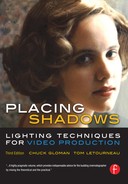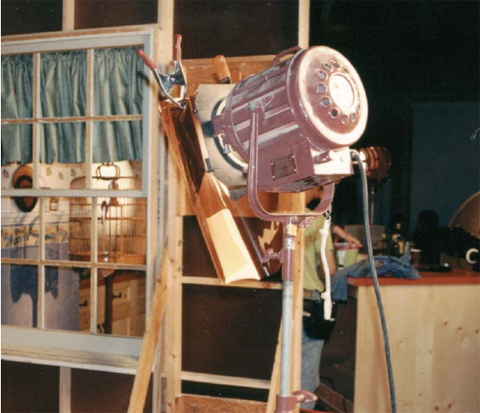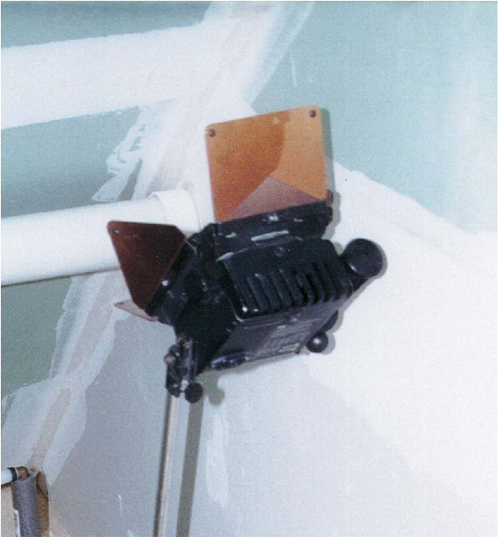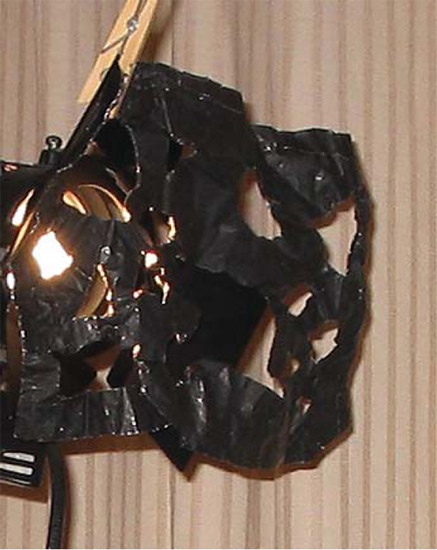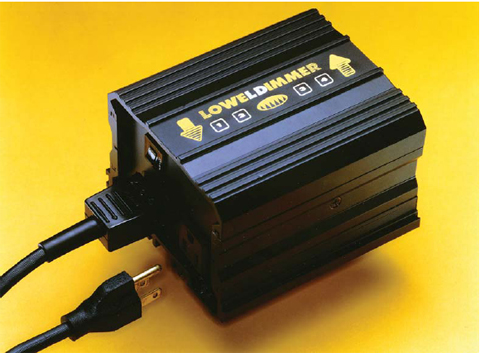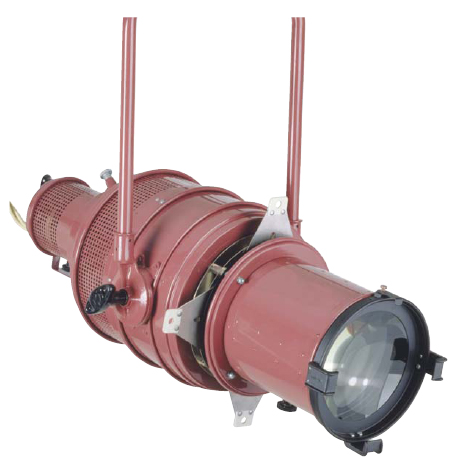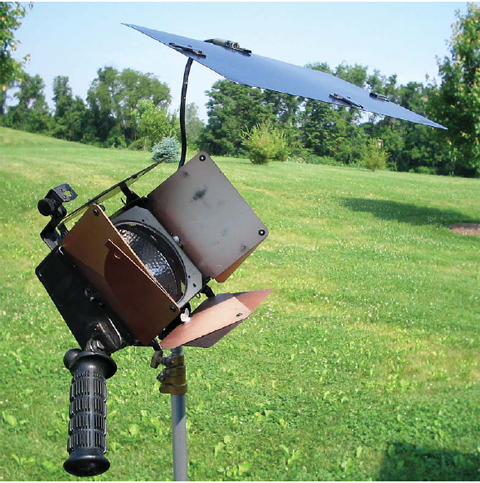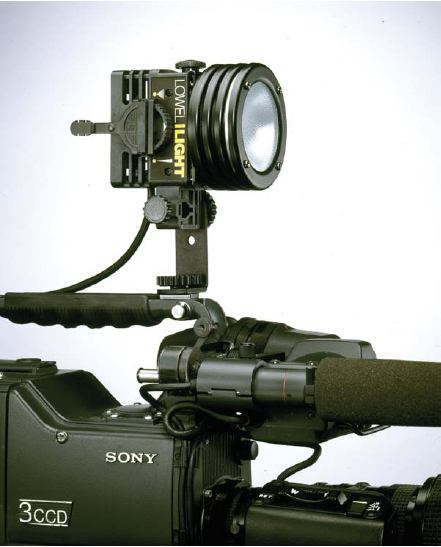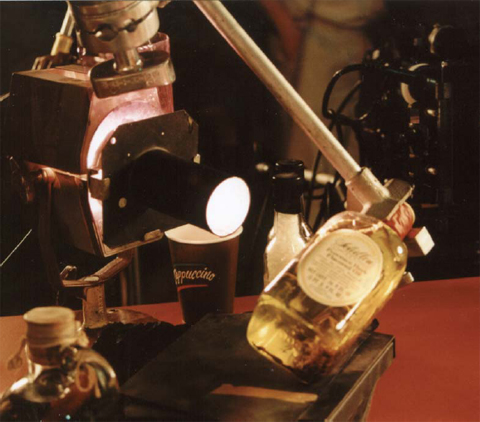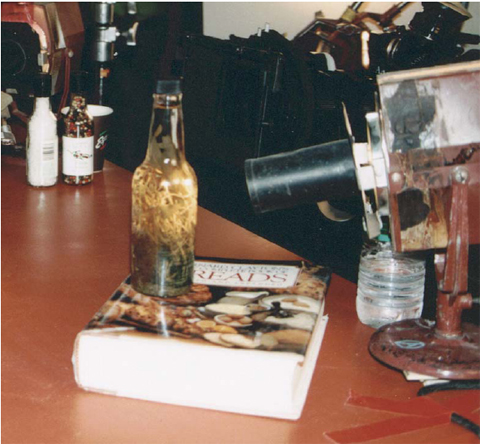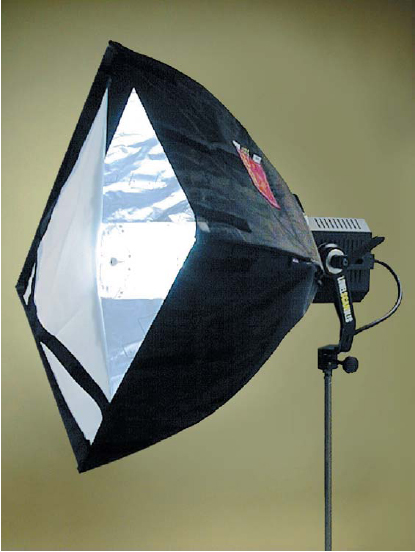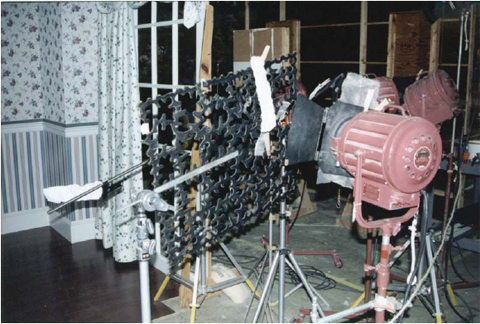Glossary, Terms and Tips
Control Yourself
These goodies are used on location and in the studio to control spill (unwanted light), alter the quality of the light, or provide mounting support. Some are physically attached to the instrument and some are placed in front on a separate stand to alter or control its output. There are also a number of accessories that are helpful in mounting instruments under a variety of circumstances. There are also many widgets that are just plain helpful in getting the job done. My list is by no means complete, but represents basic and commonly used items.
Ace is not a hardware store. It is a 1000-watt Fresnel, also known as a “baby.”
ANSI stands for American National Standards Institute. It is an independent association formed to promote consistency and interchangeability among manufacturers of lamps and lighting equipment. Though various manufacturers have different numbers for the same type of lamp, the manufacturer’s number can be referenced to an ANSI number to determine if it is interchangeable with a lamp from another company.
Apple boxes are not designed for fruit storage. They are multipurpose wooden boxes that may be utilized for sitting and standing and for prop elevation. They are glued, nailed, and constructed with internal center supports so that they can withstand hefty loads. They come in a variety of graduated sizes. A full apple is 8 inches high, a half-apple is 4 inches high, and a quarter-apple is 2 inches high. They form convenient bases for low-angle lights and hi-hat camera mounts, or for leading men who can’t quite measure up to the height of their leading ladies.
Asbestos gloves are made of a heavy, heat-resisting material and they will prevent many a burn. They may also cause cancer, so stay away from them. They are no longer sold.
Lighting instruments are potentially dangerous if handled improperly or placed too close to other objects. They are very hot. A 750-watt tungsten halogen filament burns at a temperature of 5300°F. The outside wall temperature of a lamp is 1100°F. The temperature of accessories placed in the gate of a Leko is 1575°F. You need protection when working with these temperatures. Thin cloth gloves won’t do! Buy heavy-duty work gloves or gloves with leather fingers and thumbs.
Baby is a 1000-watt Fresnel, also known as an “ace” (see Figure 13.1).
Barn doors are black metal flaps attached to an instrument or placed in the accessory shoe on the front of it. They are used to restrict the coverage area of a light source. There are usually two or four flaps that can shape the lighted area. Sometimes they are permanently attached to the instrument, as with some portable broads, or they may attach to the front of an instrument in a bracket provided for that purpose. The best units are able to turn 360° around the opening of the fixture to provide more flexible-pattern positioning. They produce a diffused cut-off line. They absorb much heat, so use your gloves when you try to adjust them (see Figure 13.2).
Base light is a diffuse light level on a set that permits the camera to operate efficiently, without producing noise in the dark areas.
Batten is a horizontal pipe from which lighting instruments or scenery are hung.
Bazooka is not a gun or bubble gum. It is a method of supporting lighting instruments over the edge of the catwalk in a sound stage. It looks like an extension arm for a C-stand, and it fits into holes that are predrilled in the catwalk.
Best boy may in fact be a girl or an old codger. He or she is a crew member whose duties include repair of broken connectors, switches, or cables. He or she replaces bulbs in lights and lamps in less beefy instruments, and cleans and adjusts instruments to make sure they are ready when needed.
Blackbody is the theoretical standard used to determine the color temperature of incandescent light sources (see “Color Temperature” in Chapter 1).
Blackwrap is a heavy-duty matte black aluminum foil packaged in a tear-off roll just as household aluminum wrap is. It is used to wrap around areas of a lighting instrument that are projecting spill on some area of the set or is used as a flag, a cutter, or emergency barn doors. It’s better than regular aluminum foil because it withstands the high temperatures of lighting instruments, and its matte black finish does not produce objectionable reflections anywhere around the set (however, it sometimes smokes when it is first used). It is available from Great American Market and Rosco (see the Appendix) (see Figures 13.3 and 13.4).
Borderlight is also called an “X-ray.” It is a striplight that is mounted above the acting area. Primarily used in theater, these same instruments may be used on the floor in front of the acting area as footlights or on the floor upstage as cyc lights.
Bounce cards are matte white reflectors used to redirect the light onto the subject after it has left the source. They can also be used to redirect wasted spill to an area where it is required, without the need for an additional instrument. Any reasonably stiff material will do. Foam board or Foam core is lightweight, easy to cut, and will stay put when placed in a gobo head and carefully positioned. Since the bounce light from a card is so diffuse, these cards must be placed close to the area you wish to light, just outside camera frame.
Bull switch is a master circuit breaker or fuse box with manual disconnect switch used at the head end of an electrical tie-in system. It is placed between the entrance panel from which the power is taken and your distribution system to provide protection and permit complete power-down of all your equipment.
Butterflys or “overheads” are large rectangular aluminum frames over which you can stretch a variety of materials to diffuse sunlight or natural light on exterior or interior locations. They may be as large as 20 feet on a side, and cover an area large enough to permit shooting close-ups or medium shots. They work well in studios when placed between multiple instruments and a subject, such as a car. They eliminate multiple-source reflections from the shiny compound curved surface (see Figure 13.8).
Cameo or “limbo lighting” is a style in which only the foreground area is lit. The background is allowed to go black (as seen in Figures 6.1 through 6.4). It is a dramatic form that is economical because of the lack of scenery, and it keeps the viewer focused on the people or products without any distracting elements.
Chasers are lamps that are placed in a multicircuit string and connected to a control device that turns every fourth or fifth lamp on and off in sequence, to create the illusion that the lamps are moving in a forward or backward direction. Such arrangements are commonly used around marquees, signs, or runways to draw attention.
C-clamps derive their name from their shape, and they are used when extremely secure quick mounting is required. Nothing works as well. They come in 4-inch, 6-inch, and 8-inch sizes. True lighting C-clamps have one or more ⅝-inch studs welded to their frame to facilitate the attachment of portable lighting instruments.
C-Stand is short for “Century Stand.” It has three legs (each one slightly higher and longer than the next) that can be folded flat in a 90° angle to the shaft and nested to make transport easier. These legs are spring-loaded and snap into their working position quickly for setup. The shortest leg can be set under most furniture and the tallest leg can fit over or around various other stands or items on set. Though they are somewhat expensive, they are extremely sturdy, take a real beating, and are well worth the cost. Available in several different sizes, they are a must on every set.
Cliplock is an alligator-type connector used to attach the leads for your electrical tie-in system to the bus bars of the entrance panel. These special connectors provide a very strong mechanical connection that cannot be pulled off their point of attachment. A bolt arrangement ensures that the clip will not open.
Color frames or gel frames are thin, rectangular sheet-metal sandwiches that have a large hole in the middle. They are used to hold color filters such as gel, diffusion material, heat filters, or neutral density or color-correction media. In most cases, they slide into the bracket that is used to attach barn doors. Both barn doors and color frames can be used at the same time, if desired. In some of the more portable fixtures, such as the Lowel lights, they are collapsible frames with clips to hold the filter and diffusion materials mentioned. They prevent instrument heat from warping the material immediately and destroying it (see Figure 13.5).
Cookie (pronounced KOOK’-ee) or “cucoloris” (pronounced kook-a-LOR’-is) is used to create a shadow pattern on backdrops and/or subjects. Positioned in front of a light source, it breaks up an evenly or flatly lit area into interesting pools of light and shadow. You can buy commercially produced cookies made of ¼-inch plywood painted black or you can fashion your own out of tagboard or Foam core using a utility knife. Be careful not to place such homemade units too close to the light source as they may scorch. Greater separation also permits a sharper focus of the projected pattern (see Figure 13.6).
Cyc light is a special, high-intensity form of flood or broad that is used to illuminate cycloramas (see Chapter 10 and Figure 13.7).
Cyclorama or cyc is a cloth or plaster surface that is used to surround the acting area and to create the illusion of infinite depth (see Chapter 10).
Deuce is one up on an ace. It is a 2000-watt Fresnel; also known as a “junior.”

Figure 13.7: Cyc lights strip with stage paddles (Photo courtesy of Mole-Richardson Co.).
Diffusion material is used to produce diffuse light. Made from a variety of substances, it will alter the quality of light that passes through it, making it more diffuse, producing less dense shadows, and creating light that falls off more rapidly. It can be purchased in precut squares or as roll material. You can place it in a color frame or suspend it in front of an instrument using various other devices.
Dimmers are used to lower the voltage applied to the filament of a lamp and lessen its intensity. While they are mandatory for creating a variety of effects, they also reduce the lamp’s rated color temperature and are not an acceptable method of reducing intensity of talent light (see Figure 13.9).
Dinky is a 200-watt, 3-inch Fresnel with a sheet metal frame (see the discussion of Inky).
Dots are small round wire loops attached to a wire handle, something like the device children use for blowing bubbles. They can be covered with a variety of things, from thin netting or wire scrim to opaque material, and are used to control or eliminate a specular highlight and other lighting problems. Like flags, they are held between the source and the subject by gobo heads. Unlike flags, their small size affects only a limited portion of the lighted area. They are usually available in 3-inch, 6-inch, and 10-inch diameter sizes (see Figure 13.10).
Downstage is the area of the stage that is nearest the audience. The term stems from the early Greek theater where the stage was actually racked. The stage floor nearest the audience was lower than the floor farther from it. In this way, as actors walked away from the audience, they were not hidden behind foreground players.

Figure 13.10: Dots (Photo courtesy of Mole-Richardson Co.).
Dressing cables is a phrase used to describe the act of arranging the path of lighting and sound cables so that they do not interfere with traffic patterns on the set or appear in the shot. It is important to dress and tape cables out of harm’s way, especially if you have to run them down halls and across doorways in an office building or other public area. It is not advisable to dress audio and lighting cables alongside each other. That frequently introduces a 60-cycle hum in the audio. In effect, what you do when you place these cables parallel to one another over any distance is create a giant transformer. Place either cable over the top of the other to create a cross; this will eliminate the hum. Gaffer tape should be used to dress cables where foot traffic might cause a problem.
Drop ceiling scissor clamp and cable holder is a mount designed to close with a scissor action over conventional T-bar drop ceiling frames. It is fitted with a standard ⅝-inch stud to allow mounting of lightweight location fixtures. Some studs also contain brackets that can be used to drape electrical cords across the ceiling without the need for tape or other unreliable antigravity devices—a necessary device in every grip kit (see Figure 13.11).
Edison plug or “Edison outlet” is the term given to the traditional grounded plugs or wall outlets used in the home (U. S. and Canada). The outlets contain two parallel slots of different lengths. The longer of the two outlet slots or the wider of the two plug prongs correspond to the neutral wire of the circuit. The outlets have a circular ground hole that mates with the ground pin of the plug. Outlets with one T-shaped slot indicate a 20-amp capacity circuit. These outlets do not require a special plug to mate with this T-slot. Efforts to defeat the grounding and polarity aspects of such plugs and outlets are not a good idea. The polarized aspect of the prongs and the grounding pin can prevent nasty shocks in the event of cable or equipment failure.
Egg crates are not used for storage of poultry products. They are deep, wooden frames that form several cubicles, and they are placed in front of a softlight to diffuse the light rays even further.
Electrician is the crew member responsible for bringing the power from its source to the lighting instruments through the distribution system. The source may be a tie-in, a temporary drop, or a generator.
Ellipsoidal or “Leko” is a lighting instrument with an elliptical reflector and a complex lens system that makes it possible to place light exactly where you want it without the need for any external accessories to control spill. A series of shutters, an iris, or a gobo can be sharply focused onto an area of the set (see Figure 13.12).
Fill light is the diffuse light placed to reduce the contrast of the shadows cast by the key light. It should never be bright enough to cast its own shadow. If for some reason it does cast a shadow, the instrument should be placed so that the resulting shadow falls out of range of the camera.
Fingers are similar to dots in function, but they are long, thin rectangles of material used to block light on a rectangular portion of the subject. They come in 2 × 12-inch and 4 × 14-inch sizes. They are covered with a variety of diffusion materials (see Figure 13.13).
Flags or “cutters” are square frames covered with opaque material to block light from certain areas. Such unwanted light is called “spill.” Flags are placed in front of an instrument on a stand of their own and positioned to cut the light where needed. Depending on their placement, they offer a more defined cut-off point than barn doors because they can be positioned farther away from the front of the instrument. Cutters are similar to flags except that they are like large fingers, long and narrow.
French flag is a term given to flags that are made of metal rather than opaque material or some form of scrim material. They are the type of flags provided in the Lowel kits (see Figure 13.14).
Frezzi is a well-known and well-respected battery-operated, camera-mounted light. Frezzolini was the first firm to produce a rugged camera-mounted DC light for news coverage and the name is often used in a generic sense to describe any such instrument regardless of the manufacturer (see Figure 13.15).
Gaffer is not the person responsible for making mistakes. He is responsible for designing a lighting plot for each scene after consulting with the director, the director of photography, or the camera operator. After the plot is approved, the gaffer directs the laying of cables and puts the instruments that are going to be used in place at the proper height. At that point, the grips take over.
Gaffer grips are like large, metal, spring-operated clothespins. They have one or more standard ⅝-inch studs attached to them and are designed to hold lightweight instruments or accessories in position on pipes, the edge of doors and other objects around the set (see Figure 13.16).
Gaffer tape is a specially formulated 2-inch wide cloth tape, available in several colors, and commonly confused with duct tape or furnace tape found at the local hardware store. Duct tape is not the same and should not be substituted. Gaffer tape will not damage painted or stained wood surfaces, and will not leave a sticky residue. It can be used for anything from securing cables to mending the leading lady’s dress. It can be applied to silver subjects such as car bumpers to reduce glare, and it looks convincing on camera. Duct tape is too shiny for this purpose. Always have plenty of gaffer tape on hand.
Gobo can mean different things, depending on who is speaking. Lighting directors are probably talking about a precut metal disk that is inserted in the gate of a special pattern projector or Leko to project a specific image on the set or actors. These come in a wide assortment of effects, ranging from fireworks displays and American flags to venetian blinds and trees (see the Appendix).
Grips talking about gobos are probably referring to a Tinker-toy-like metal disk that is fastened to the extension arm of an accessory stand. Gobo heads or grip heads are available in 2½-inch or 4½-inch diameters. They mount on standard ⅝-inch pins and are designed to receive ⅝-inch, ½-inch, and ⅜-inch round accessories. They will also accept irregular shapes and flat objects like handmade flags of Foam core.
Just for fun, if camera operators are talking, they would be referring to some object in the foreground of the set that the camera will shoot through, or move past while shooting the scene. It may be a decorative screen or the andirons of a fireplace.
Audio technicians are probably referring to portable sound deadening panels that can be placed around individual musicians in a studio to isolate the sound of their instrument from others to give the mixing engineer greater control over the mix. Quick now, what is a gobo?
Grips are crew members who set up lighting accessories such as flags, gobos, C-stands, etc., at the direction of the gaffer. They control spill and intensity through the use of a variety of accessories. Their duties may also include the placement of props on the set and assisting the camera operator.
Inky is a 200-watt, 4-inch Fresnel with a cast metal frame (see the discussion for “Dinky”) (see Figure 13.17).
Kelvin is a temperature scale that corresponds to the centigrade scale but has its zero at –273°. It is the scale used to measure the color temperature of light.
Lamp is the technically correct name for a light bulb. It is a gas-filled envelope containing a filament.
Leko is a brand name ellipsoidal, named for the inventors (see the discussion for “ellipsoidal”).
Lowel clips are extremely handy reusable plastic fasteners that wrap around rolled up cables to keep them together and prevent them from getting snarled with other cables. They are completely adjustable and provide a ring at one end from which to hang the cable. They can be removed instantly and do not leave a sticky residue on the surface of your cables.
Mole pin is a male and female pin plug system made by Mole-Richardson. Heavy-duty copper pins are connected to one end of welder’s cable to provide an easy disconnect method of heavy current loads in the distribution system of your electrical tie-in. They simply push into heavily insulated matching female sockets.
Neutral density filters reduce the light output of an artificial light source (or the sun) by a specified amount equally in the red, blue, and green spectrum. They do not affect color temperature. They may be built into the camera, attached to the front of the lens, placed in front of an instrument, or placed on windows to reduce incoming sunlight. Common values for ND filters are 0.3, 0.6, and 0.9, which reduce light by 1, 2, and 3 stops, respectively. When talking about such filters, refer to them as “point three,” “point six,” or “point nine.”
Nineteen hundred box is another one of those strangely named items with a missing etymology. It is nothing more than a standard 4 × 4-inch metal outlet box containing two sets of duplex Edison outlets.
Paddles are rectangular male plugs constructed of a good insulator with brass strips on the narrow edges that mate with the power strips inside a stage box.
Pantograph is a counterbalanced hanging device that lets you quickly adjust the height of a lighting instrument hung from the grid. Because of the counterbalance spring, you can lower the instrument and it will stay put when you release it. Pantographs permit you to adjust the height over a 12-foot range, so you can place shadows where they are most effective. Some pantographs permit the hanging of two instruments on the same unit.
Photometrics or performance data are light output specifications for a lighting instrument. They state the intensity of the light produced at various distances from the source and indicate the area covered at the stated distances. If the instrument is a focusing spot, that information will be given for the full spot position, the full flood position, and possibly for a midrange setting. This information may be presented in a simple numeric chart, with graphic drawings or with photos of the coverage area in addition to printed statistics.
Pigeon is a small metal plate with a 2⅝-inch rod extending upward. This unit acts as a light stand. Perfect for Inkys, a pigeon lets you place a light extremely close to the floor.
Practical is a term used to describe any lighting fixture or prop on stage that actually works. Items such as table lamps or radios can be practical.
Reflector boards are designed to redirect natural or artificial light. They generally have two sides or faces that offer specular and diffuse reflective, in either silver or gold surfaces. The silver side produces a harsher, colder (blue) reflection, whereas the gold side produces a softer, warmer (orange) look. They are like bounce cards, but their output is more specular, and they have greater throw. They are normally covered with smooth silver foil on the “hard” side and textured silver leaf on the “soft” side. Gold leaf is also available. The warm tone of its reflection is very complimentary to dark skin.
Sand bags provide additional weight to C-stand bases and other portable objects that could easily fall over if not weighted down. They are traditionally filled with sand and weigh between 15 and 35 pounds. If a sand bag leaks during a shipment with cameras and recorders, it can wreak havoc with the technical gear. For this reason, it is best to use shot bags that contain small, metal BBs instead. If you extend your stands, use shot bags.
Scrims or “nets” are nonelectrical dimmers. They provide a controllable means of reducing light output without affecting color temperature or generating radio frequency interference. Open-end scrim frames are made of spring steel to provide constant tension on the exposed cloth edge. The open end facilitates feathering or blending the edge of the light beam without causing a harsh line. A lavender scrim causes a 15% light reduction. Singles reduce light output by about 30%. Doubles cut back by about 50%. Exact effect depends on placement. Some are made of cloth mesh, others are made of silk. They can be held in front of the source by gobo or grip heads on C-stands.
Sliding rod is an economical means of adjusting the height of lighting instruments hung from a grid. The rods come in different lengths that allow you to raise or lower the instrument by releasing a thumb screw on a sliding ring that is fastened to the fixture. Lights hung from a pantograph can be adjusted from the floor by using a stick. Lights fastened to a sliding rod must be adjusted from a ladder and require a great deal of time to set up. Unlike the pantograph, which collapses as the light is raised, the sliding rod remains the same length regardless of how high the instrument is placed, and it may hang down in front of some other light and cast a shadow on the set. Some sliding rods telescope into shorter lengths (see Figure 13.18).
Snoots are cylindrically shaped attachments resembling stovepipes. They are attached to the front of the instrument in the color frame bracket. They confine and narrow the light produced by a spot or flood (see Figure 13.19).
Spike is not something you do to a volleyball, and it’s not the network for men. It is the act of placing a piece of tape on the floor to indicate where some prop or piece of furniture should be placed, or to indicate where an actor should stand so he will be in the right position for lighting and camera shots. The actor’s spike mark is usually two pieces of tape in the shape of a “T.” When he hits the mark, he places one foot on either side of the leg of the T, facing in the direction of the T’s crosspiece.
Spill is a term for light that falls on some area of the set where it is not wanted. Somewhat like a child’s milk.
Stage box is a rectangular-shaped porcelain receptacle in a heavy metal box used to distribute moderately heavy loads of current. It comes in a variety of capacities and configurations. Stage plugs or paddles are inserted into the stage box to tap a portion of the available current.
Stage left is an instruction describing movement or a location to the left of actors as they face the audience or the camera. Stage right shouldn’t need any explanation.
Stage plugs are heavy-duty insulated plugs used with stage boxes for the distribution of current around the set. Large brass strips on each side of these plugs make contact with the brass lining of the stage box. Generally, the stage plug is on one end of an extension and nineteen hundred boxes are connected to the other end for distribution through standard Edison outlets.
Sticks is slang for a “camera’s tripod.”
Strike means to remove something from the stage area and place it out of the way. It is also used to describe the action of packing up your equipment or taking down a set for storage or disposal.
Teners are not opera singers. They are 10,000-watt Fresnels (see Figure 13.20).
Tree is a high stand with horizontal arms and a very heavy metal base from which lighting instruments can be hung. Generally used in theaters, it can be employed on any location to mount one or more instruments from the same stand. Sometimes, small tower-like structures for mounting instruments are also referred to as trees.
Trick Y is a Y-shaped cable arrangement used to split a single leg of an electrical distribution system into two legs.
Umbrellas are made of a textured silver fabric like that used in portable softlight reflectors. They make it possible to use spotlights and broads as sources for diffuse light. You simply aim the fixtures at the inside of the umbrella when it is open. The reflected output is very soft and uncontrollable. Like any diffuse light, it falls off quickly so you must be able to position it near your subject. Open-faced instruments work best as sources for umbrellas. If you are using a focusing spot, do not put it in the full spot setting as it may destroy the umbrella material due to excessive heat. Fresnels can be used as sources for umbrellas by removing the lens (see Figure 13.23).
Upstage is the area of the stage that is farthest from the audience (see “downstage”). When used as a verb, it means that one actor is pulling focus or audience attention away from another at a time when this actor should not have the attention.
Work lights are permanently installed general lighting fixtures in a studio or stage and are used to provide light for setups and general work on set. They should always be turned off during shooting since they are not color-corrected and will cast multiple shadows and unwanted spill.
Zip is not a postal code. It is a 2000-watt (or less) portable softlight or a name applied to a common household lamp cord, called “zip cord” (see Figure 13.21).
See Figure 13.22 for an example of a completed lighting setup.
Your Gadget Bag
In many cases, location lighting is an unplanned event. You are told to “go to Widgets, Inc. in East Nowhere and shoot Mr. Bumfutz and his two assistants as they take a Widget from the drawing board to the shipping clerk.” With little advance information, you are driven to the airport with 22 cases of assorted goodies hoping you have what you need. You might, or you might not. If you don’t, improvise. That’s the excitement and satisfaction of the job. Lest you become too excited or satisfied, a few things can save you anxious moments.
Carry your own gadget bag and keep it filled with those little things that make the unexpected manageable. I use the term “bag” loosely because I’ve found that keeping these items in a canvas bag defeats the idea of being organized. If everything is thrown into a bag it makes it difficult to find the specific item you need. You are also likely to leave something behind when you strike everything and pack up to go home. You can’t tell from looking into a bag if everything is there.

Figure 13.23: Umbrellas on the set.
From a canvas bag I progressed to a metal box with various compartments so things could be organized and I could tell at a glance if something was missing. That created a problem at airports. I now carry a small compartmentalized briefcase that can be X-rayed and placed under an airline seat or in the overhead compartment. If I am driving to a shoot, I still use the metal case.
Here are some suggested items that can make your life easier. They are not presented in any particular order of importance. In fact, the most important item is the one you don’t have.
1. Take along a number of triplets or “3fers,” also called “cube taps,” which allow you to plug three things into a single outlet or extension cord. Buy the heavy-duty, grounded type (gray, blue, or orange). The lower the gauge, the better.
2. Keep a good number of adapters with you that will allow you to plug grounded equipment into ungrounded outlets. Never break off ground pins to accomplish this mismatch. It’s unsafe and unprofessional!
3. Keep an analog or digital Volt-Ohm meter to check voltage, fuses, lamps, and cords for continuity. Take along a spare battery for your meter. Just when you need the meter most, the battery will die and you will be in Littletown, USA on a Sunday with all the stores closed.
4. A helpful item to have is a plug-in, three-wire outlet analyzer. It looks like a grounded male plug with three indicator lights to show the condition of an outlet without probes or meters. You can confirm working circuits and check for wiring faults like open ground or hot wires and reversed polarity.
5. Be sure to carry some tools. An adjustable wrench and a small screwdriver set with Phillips and regular blades will be invaluable in making last-minute repairs. A set of Allen wrenches is also a good investment. Often, the focus knobs of instruments are secured or semi-secured by Allen screws. Leatherman or some less expensive imitators allow you to carry almost every tool in a pouch attached to your belt.
6. Have plenty of spring-clamped clothespins to hold filters, gels, or diffusion material to the front of lighting instruments or barn doors. Be sure to use the wooden version. The newer plastic type will melt down almost immediately and produce a foul smell on the set. Burning wooden clothespins smell better. When using any type of clothespin (wooden or plastic), make sure they are not attached too close to the light source. The farther you attach the clothespins from the source of heat, the less chance of burning.
7. Take black, white, or yellow china markers along. They allow you to write on metal and glass surfaces and mark reference points on the video monitor, the waveform monitor, or the vectorscope. You can mark focus and zoom stops on the lens barrel and use them for a variety of other tasks.
8. A small roll of white surgical tape. This tape can be ripped into small pieces and attached to the lens to mark focal positions and possibly help an errant doctor.
9. Don’t forget the can of dulling spray. If you do, there’s sure to be a stainless steel tank in the background of three shots. Something that works even better to cut down glare on bright metal surfaces is hair spray. Hair spray in aerosol cans is available at many drug stores.
10. You will always find use for a roll of clothesline rope and some heavy twine.
11. Monofilament fishing line will allow you to suspend things invisibly and trigger certain special effects from off camera.
12. Rubber doorstops have many uses. They can keep doors open, such as doors that lock when closed and doors that can’t be opened without a special key that is not around. They can level props for the camera and keep things from moving off their marks.
13. A utility knife can cut cheese and pizzas to make life during breaks more livable. It also comes in handy for cutting color media and filter material, as well as for stripping wires and cutting ropes, tape, and Foam core. You can also use it to carve out a gobo.
14. To keep cords and ropes neat, there is nothing better than a large supply of Lowel-Clips, those plastic wonders that don’t leave a sticky mess on your cables.
15. Several rolls of gaffer tape are a must. It comes in yellow, blue, green, silver, black, white, and several fluorescent colors. Have plenty on hand to tape and mask a variety of things on set.
16. Double-stick foam tape is a good thing to keep throw rugs from living up to their name. It can also fasten lightweight pictures to walls and keep frames from tilting. Almost anything that slips out of place can be tamed using this product.
17. Always carry spare video connectors like RCA to BNC, BNC to RCA, splitters, barrels, and any other type of video or audio connector you may need. Ten minutes in a Radio Shack before the shoot will keep you from losing your hair on the set. Also carry spare BNC and audio cables. They are easily misplaced and very embarrassing if you forget them.
18. It is a good idea to carry small squares of different types of diffusion materials, 85, ND in various stops, and some booster blue to gel individual instruments or treat small window areas or practical instruments on set.
19. Although not a lighting item, carry a spare set of ear buds (earphones). These are not extremely comfortable, but they come in handy for checking audio levels in a pinch and can make you new sound people friends on a shoot.
More items will appear in the bag as you find you need them on a shoot.
Beyond Your Gadget Bag
There are some larger items that won’t fit in your bag, but they should travel with you as excess baggage if you are flying.
1. Always have plenty of spare lamps in a variety of wattages. They permit you to use the lowest wattage lamp necessary for a given location to keep heat and current consumption as low as possible.
2. Take plenty of extension cords. Put them on simple reels. If the budget permits, it is best to have retractable cord reels to save time in setup and strike. The best kinds to use are those that have a fan-shaped 3-outlet head to permit several fixtures to be connected to a single-source outlet.
3. If you will be shooting on a location involving windows or glass doors, carry rolls of 85 gel to convert daylight to 3200°K. You should also have a roll of ND filter material in several densities and a roll of booster blue to convert 3200°K lamps to daylight. They should be in individual shipping tubes to protect them from scratches and kinking.
